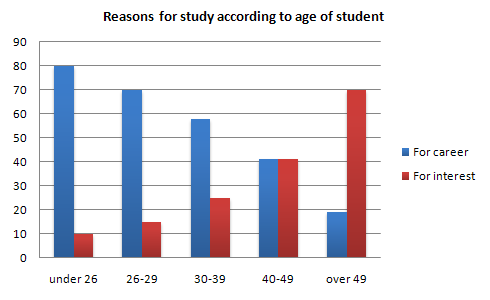The charts below show the main reasons for study among students of different age groups and the amount of support they received from employers.
Summarise the information by selecting and reporting the main features, and make comparisons where relevant.
The first chart shows the percentage of students who study for their career or interest and the second chart illustrates the amount of support from the employer among different age groups: under 26-year-old throughout over 46-year-old
While the age under 26-year-old is relatively high levels at 80% of study for their career, it seems that the percentage gradually decreases every decade and decreases dramatically at over 49 years old which is almost 4 times as much as the age under 26 years old. In contrast, the purpose of study for their interest is the lowest, only 10%, at the age under 26 years old. The percentage gradually increases and noticeably increases to 70% of over 49-year-old. In comparison at the same age of under 26-year-old, the purpose of study for their career is sharply higher than the reason for their interest. However, there is the same number of 40-49 years old educated for career and interest.
According to the second chart, the employer supports at the age of under 26-year-old the most which is approximately 60%. Then, it drops suddenly double of the age under 26 years old, and gradually increases throughout over 49-year-old.
Summarise the information by selecting and reporting the main features, and make comparisons where relevant.
The first chart shows the percentage of students who study for their career or interest and the second chart illustrates the amount of support from the employer among different age groups: under 26-year-old throughout over 46-year-old
While the age under 26-year-old is relatively high levels at 80% of study for their career, it seems that the percentage gradually decreases every decade and decreases dramatically at over 49 years old which is almost 4 times as much as the age under 26 years old. In contrast, the purpose of study for their interest is the lowest, only 10%, at the age under 26 years old. The percentage gradually increases and noticeably increases to 70% of over 49-year-old. In comparison at the same age of under 26-year-old, the purpose of study for their career is sharply higher than the reason for their interest. However, there is the same number of 40-49 years old educated for career and interest.
According to the second chart, the employer supports at the age of under 26-year-old the most which is approximately 60%. Then, it drops suddenly double of the age under 26 years old, and gradually increases throughout over 49-year-old.

G44.gif
